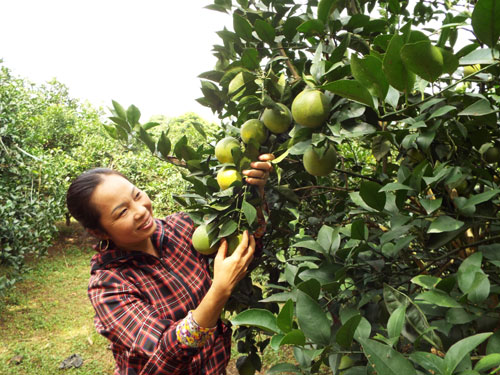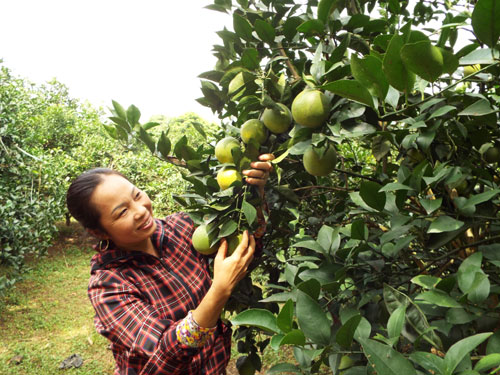
(HBO) – Cao Phong, blessed with favourable nature, is home to industrious people, many of whom have become billionaires from growing oranges.
Ms. Dang Thi Thu is the only female billionaire to be
honoured as outstanding Vietnamese farmer in 2016
Born in Hung Yen, Dang Thi Thu came to Cao Phong town to earn a living through
trade. She started to grow oranges from 2007 and has currently owned 10
hectares of oranges after surmounting a lot of hardships.
In this land, anyone who has about one hectare grown with orange with a yield
of 25-30 tonnes, the earning of millions of Vietnamese dong is within the their
reach.
Thu has grown oranges by herself for years and grosses some billions of
Vietnamese dong annually. This year, the output of oranges has been
continuously improved and is projected to yield hundreds of tonnes. Traders
have come to her garden to order the fruit. If the price is as the same as last
year, Thu is surely pocketing at least 5-7 billion VND.
Mr. Nguyen Duc Manh, another resident in Cao Phong town, began to grow oranges
from 2006 on around one hectare. So far, his family has had nearly seven out of
the total 9.5 hectares of land for growing oranges that are fruiting.
He said taking care of 1,000 oranges is equal to raising five pigs. Growing
oranges is hard but it could make farmers rich. This year, the fruit is
expected to bring him 3-3.5 billion VND in revenues.
Since receiving Geographical Indication, Cao Phong orange has continued confirming
itself as a product of high economic value. More orange growers have been
joining the club of billionaires in Cao Phong. In 2016, Cao Phong town had 100
households earning 1-3 billion VND, and some families grossing over 5 billion
VND, which reflected that a generation of farmers have dared to make the best
use of blessed natural conditions and apply modern production and management
methods to become rich.
Le Chung
According to data from the Hoa Binh Provincial Party Committee, the industrial production index for the first six months of 2025 is estimated to have increased by 20% compared to the same period last year. This marks the highest year-on-year growth rate for this period since 2020.
In the first six months of 2025, Hoa Binh province’s export turnover was estimated at 1.145 billion USD, marking an 18.11% increase compared to the same period in 2024. Import turnover was estimated at $ 804 million, a 17.15% increase, which helped the province maintain a positive trade balance.
The lives of the ethnic minority farmers in Tan Lac district have gradually improved thanks to the new directions in agricultural production. This is a testament to the collective strength fostered through the professional associations and groups implemented by various levels of the district’s Farmers’ Union.
With the motto the "product quality comes first,” after nearly one year of establishment and operation, Muong village’s Clean Food Agricultural and Commercial Cooperative, located in Cau Hamlet, Hung Son Commune (Kim Boi district), has launched reputable, high-quality agricultural products to the market that are well-received by consumers. The products such as Muong village’s pork sausage, salt-cured chicken, and salt-cured pork hocks have gradually carved out a place in the market and they are on the path to obtaining the OCOP certification.
In the past, the phrase "bumper harvest, rock-bottom prices" was a familiar refrain for Vietnamese farmers engaged in fragmented, small-scale agriculture. But today, a new spirit is emerging across rural areas of Hoa Binh province - one of collaboration, organisation, and collective economic models that provide a stable foundation for production.
Maintaining growing area codes and packing facility codes in accordance with regulations is a mandatory requirement for agricultural products to be eligible for export. Recently, the Department of Agriculture and Environment of Hoa Binh province has intensified technical supervision of designated farming areas and packing facilities to safeguard the "green passport" that enables its products to access international markets.



